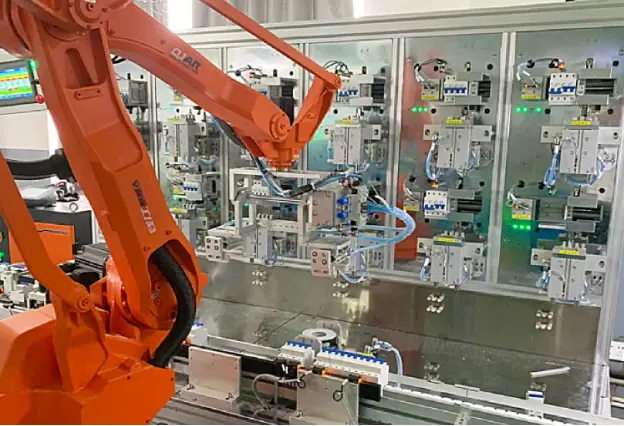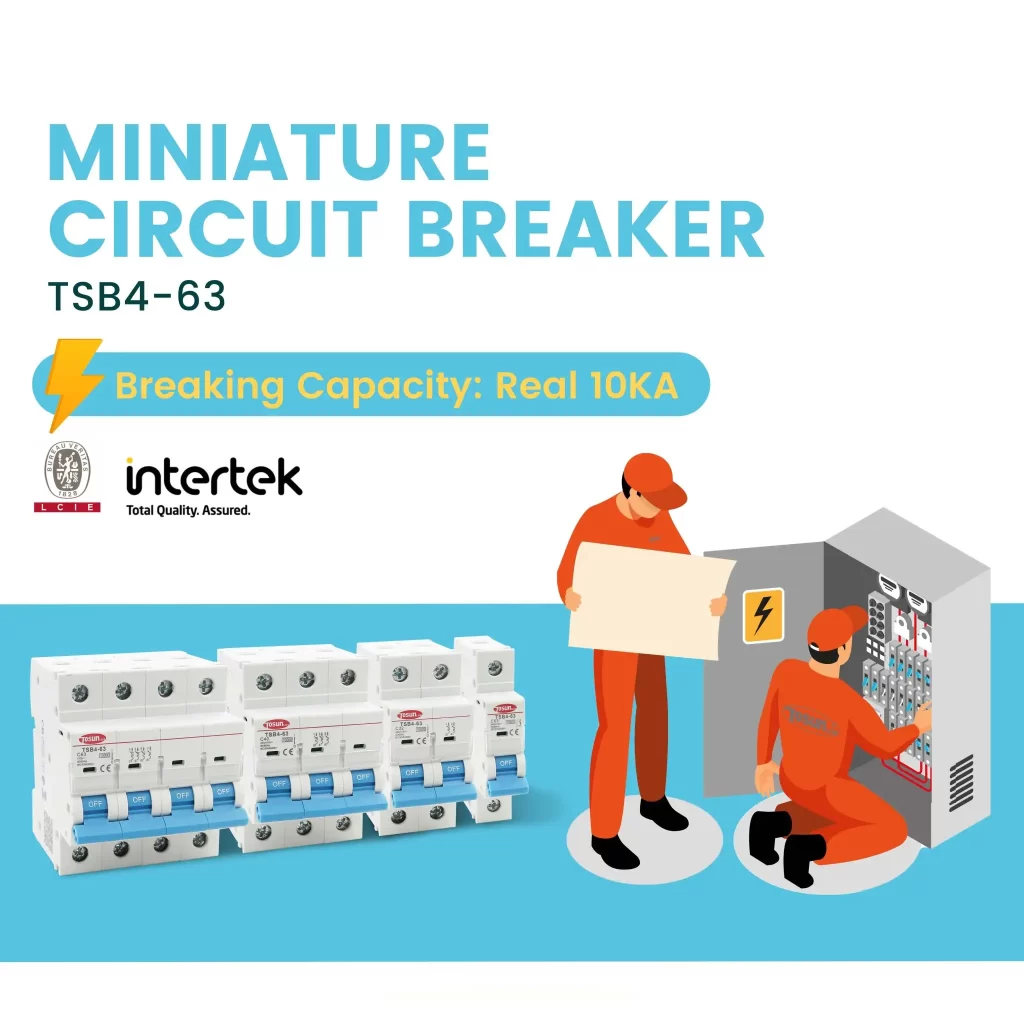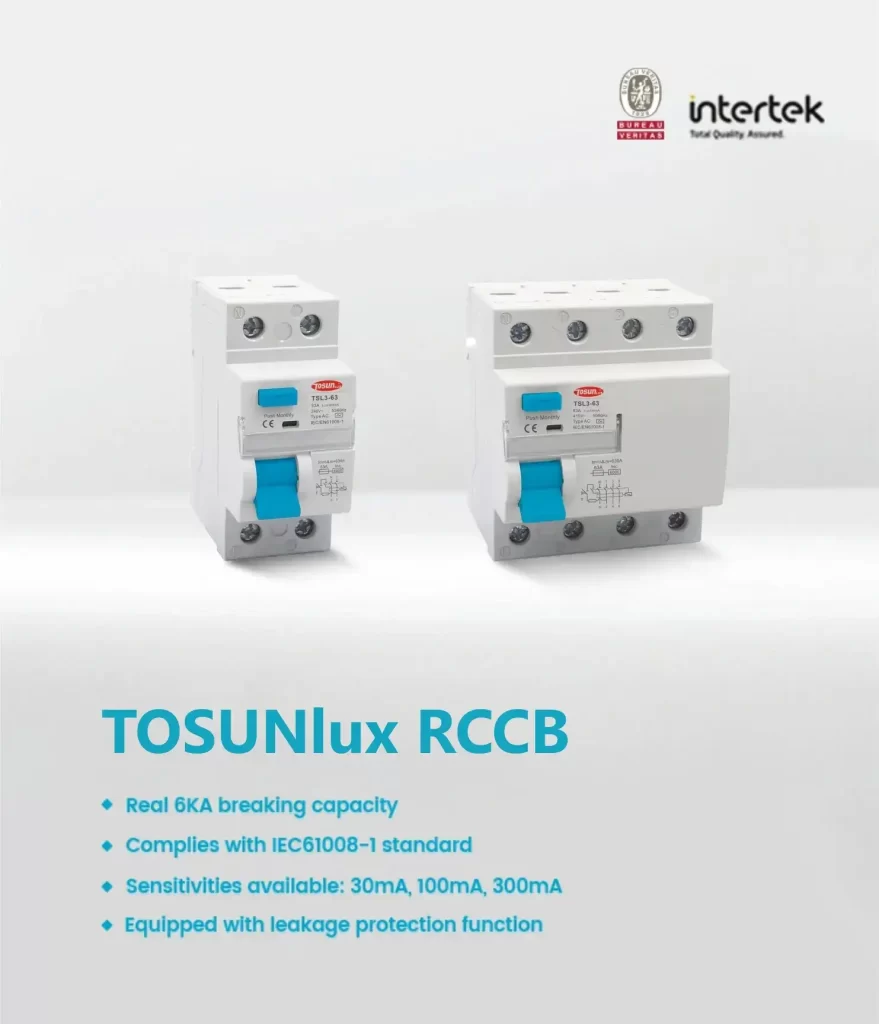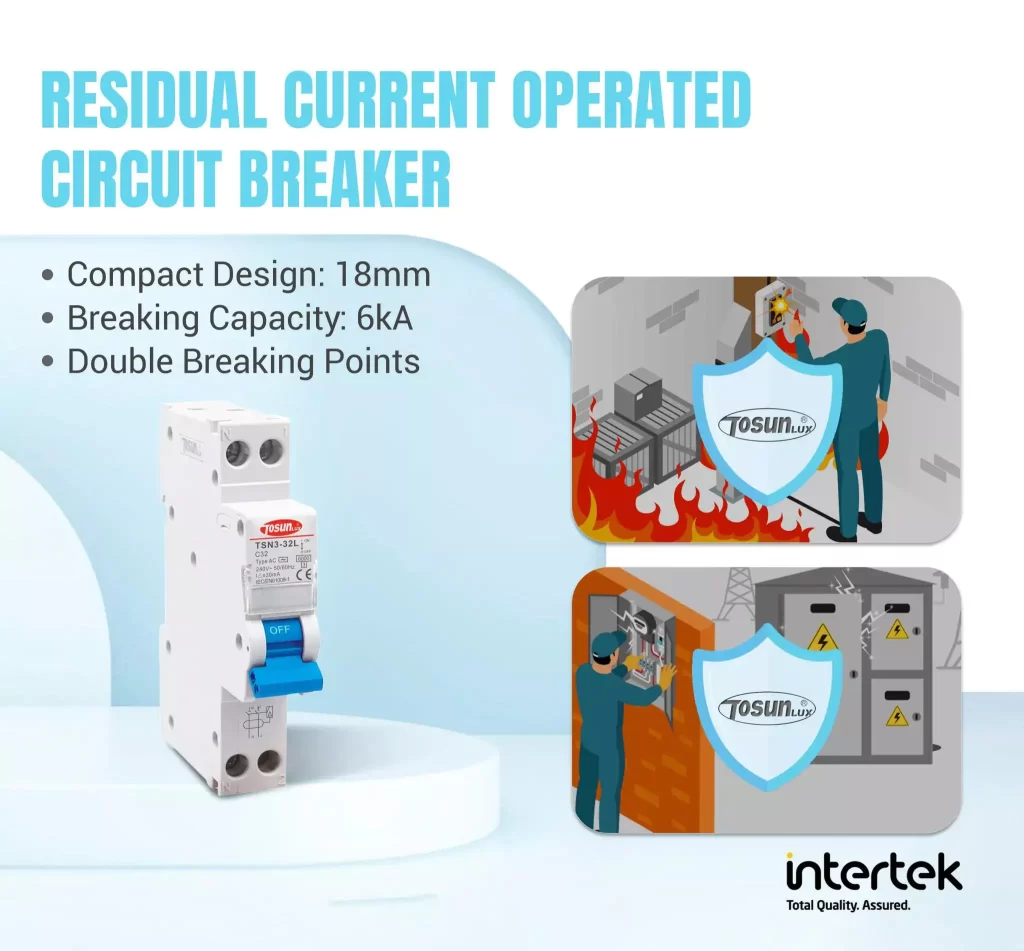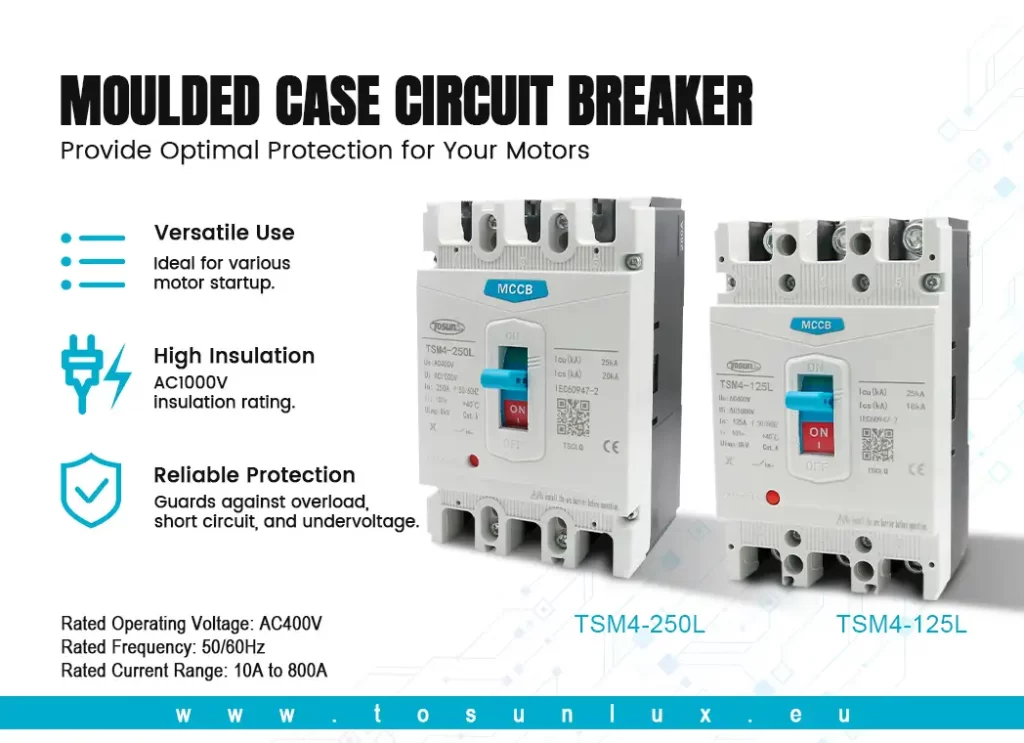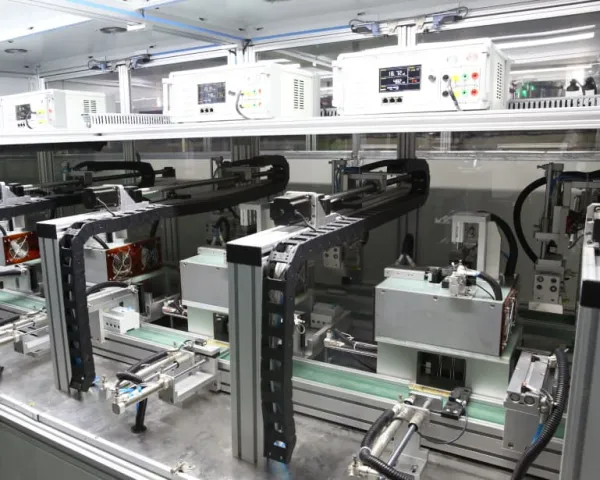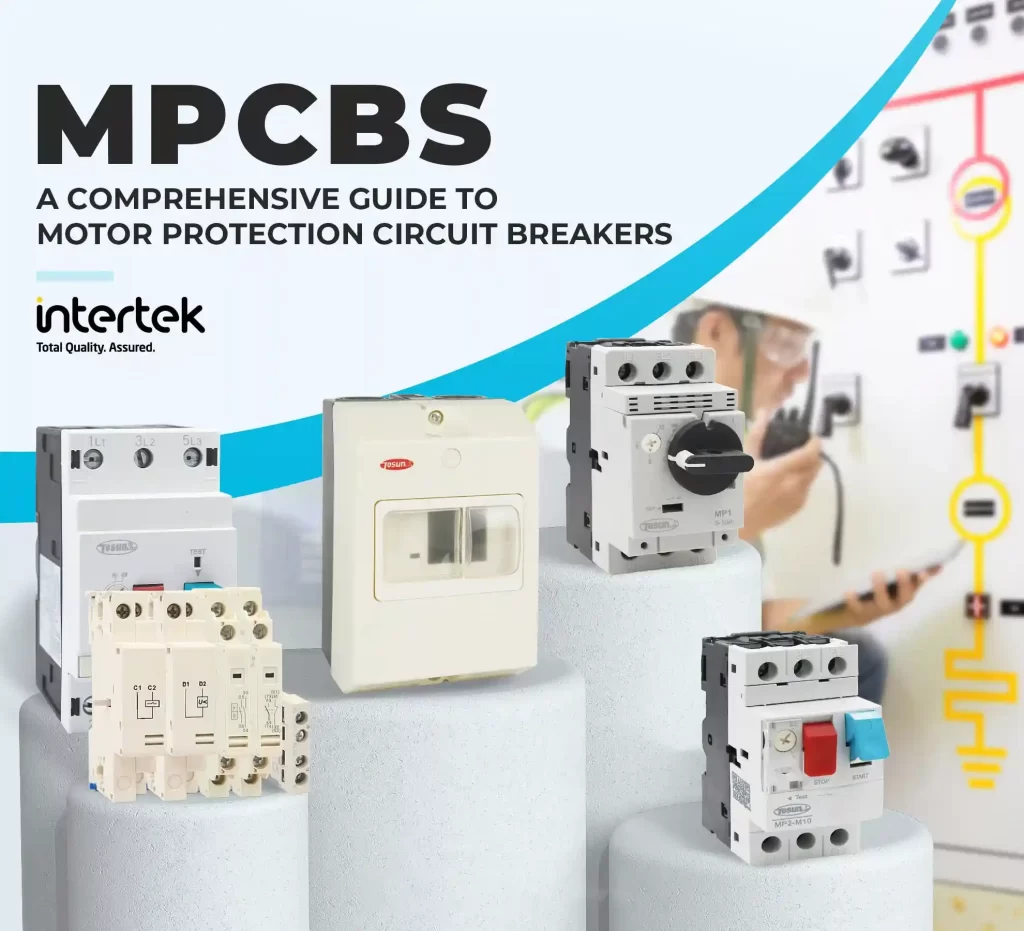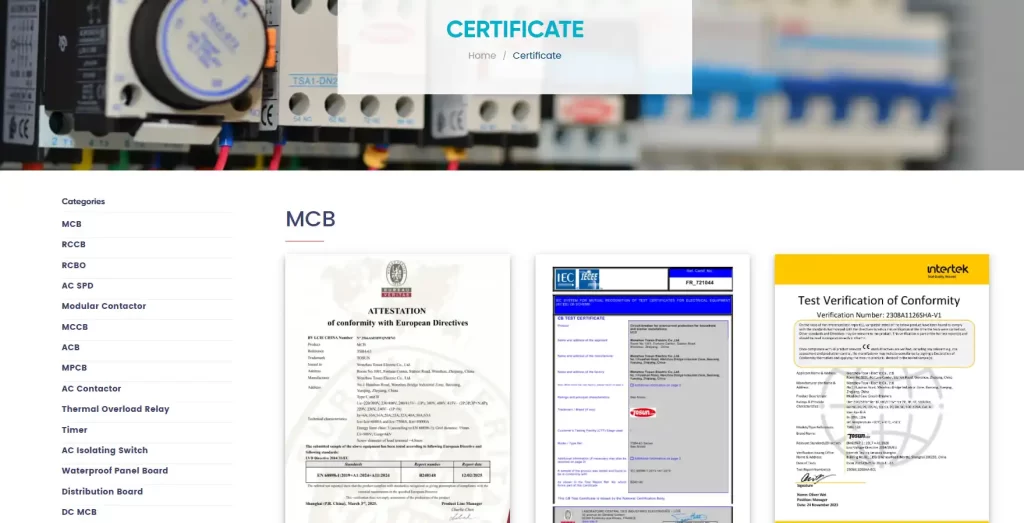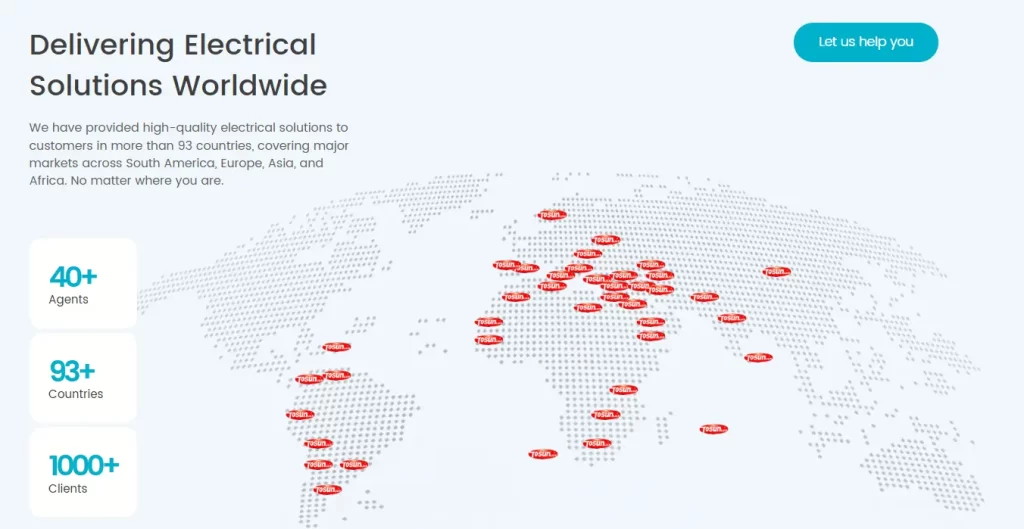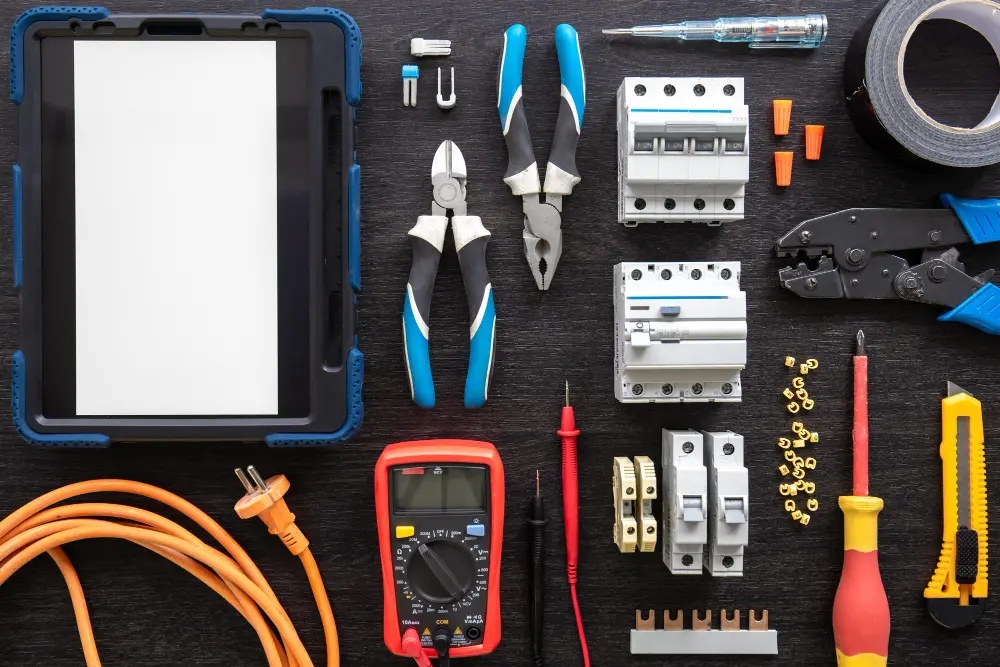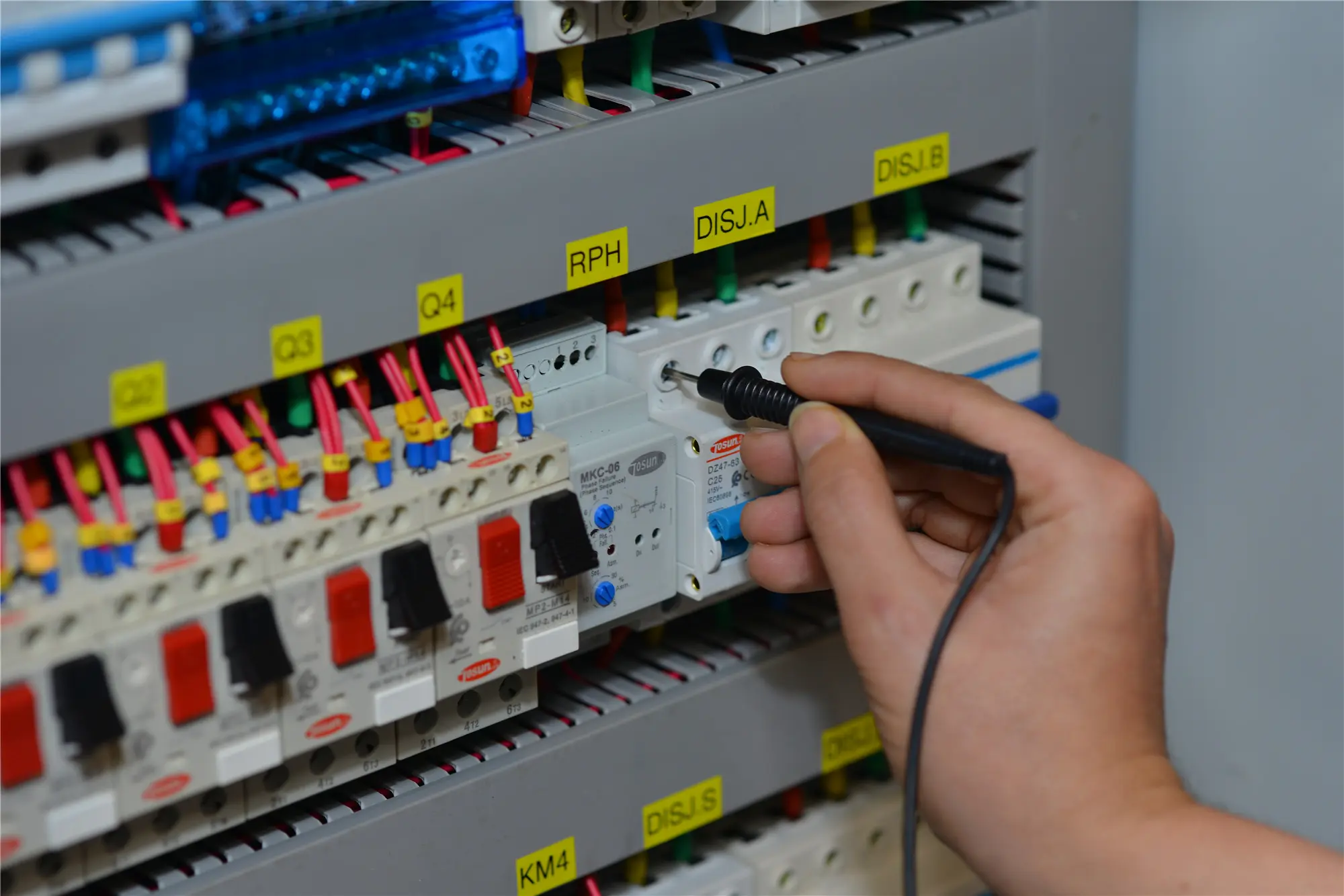MCB εναντίον RCCB εναντίον RCBO εναντίον MCCB εναντίον MPCB: Ο απόλυτος οδηγός επιλογής B2B
Πίνακας Περιεχομένων
ΜπαρέταΒασικά Takeaways
- Για χονδρέμποροι ηλεκτρικών ειδών, κατασκευαστές πινάκων και εργολάβοι, η επιλογή του σωστού διακόπτη είναι κρίσιμη, αλλά οι διαφορές μεταξύ MCB, RCCB, RCBO, MCCB και MPCB μπορεί να προκαλέσουν σύγχυση. Αυτό το άρθρο παρέχει έναν ολοκληρωμένο και οριστικό οδηγό για την αποσαφήνιση αυτών των διαφορών.
- Το MCB προστατεύει από υπερφόρτωση και βραχυκυκλώματα έως 125A, το RCCB παρέχει προστασία από διαρροές γείωσης, ενώ το RCBO συνδυάζει και τις δύο λειτουργίες σε μία μόνο συσκευή για ολοκληρωμένη προστασία.
- Το MCCB χειρίζεται ονομαστικές τιμές ρεύματος 100-2500A με ρυθμιζόμενες ρυθμίσεις διακοπής για βιομηχανικές εφαρμογές, ενώ το MPCB ειδικεύεται στην προστασία κινητήρων με μοναδικά χαρακτηριστικά διακοπής.
- Η κατανόηση της διαφοράς μεταξύ MCB, MCCB και άλλων συσκευών ηλεκτρικής προστασίας είναι ζωτικής σημασίας για τον σωστό σχεδιασμό του ηλεκτρικού συστήματος και τη συμμόρφωση με την ασφάλεια.
- Η σωστή επιλογή διακόπτη κυκλώματος επηρεάζει άμεσα την αποτελεσματικότητα της εγκατάστασης, τη συμμόρφωση με την ασφάλεια και το μακροπρόθεσμο κόστος συντήρησης για τους ηλεκτρολόγους.
Πίνακας γρήγορης σύγκρισης αναφοράς
| Τύπος συσκευής | Ονοματεπώνυμο | Πρωτεύουσα Λειτουργία | Προστατεύει από | Τυπική εφαρμογή | Αντίστοιχη σειρά TOSUNlux |
|---|---|---|---|---|---|
| MCB | Μινιατούρα διακόπτη κυκλώματος | Προστασία από υπερένταση | Υπερφόρτωση, Βραχυκύκλωμα | Κατοικίες, Ελαφρά Εμπορικά | Σειρά TSMCB |
| RCCB | Διακόπτης κυκλώματος υπολειπόμενου ρεύματος | Προστασία από διαρροές γης | Ηλεκτροπληξία, Γείωση | Υγρές τοποθεσίες, ασφάλεια προσωπικού | Σειρά TSRCCB |
| RCBO | Διακόπτης κυκλώματος υπολειμματικού ρεύματος με προστασία υπερέντασης | Συνδυασμένη προστασία | Υπερφόρτωση, Βραχυκύκλωμα, Διαρροή Γης | Σύγχρονες Εγκαταστάσεις, Κρίσιμα Κυκλώματα | Σειρά TSRCBO |
| MCCB | Χυτό αυτόματο διακόπτη | Προστασία από Υψηλό Ρεύμα | Υπερφόρτωση, Βραχυκύκλωμα (Υψηλή Χωρητικότητα) | Βιομηχανικοί, Εμπορικοί Τροφοδότες | Σειρά TSMCCB |
| MPCB | Διακόπτης προστασίας κινητήρα | Προστασία ειδικά για τον κινητήρα | Υπερφόρτωση κινητήρα, απώλεια φάσης, βραχυκύκλωμα | Βιομηχανικοί κινητήρες, αντλίες | Σειρά TSMPCB |
Τι είναι ένας μικροδιακόπτης (MCB);
ΕΝΑ μινιατούρα διακόπτη κυκλώματος (MCB) είναι μια ηλεκτρομηχανική συσκευή σχεδιασμένη να απενεργοποιεί αυτόματα τα ηλεκτρικά κυκλώματα υπό μη φυσιολογικές συνθήκες, όπως π.χ. υπερφορτώσεις ή βραχυκυκλώματαΕίναι μία από τις πιο συχνά χρησιμοποιούμενες συσκευές ηλεκτρικής προστασίας, που χρησιμεύει ως θεμελιώδες στοιχείο στις σύγχρονες ηλεκτρικές εγκαταστάσεις για την προστασία τόσο των συστημάτων καλωδίωσης όσο και των συνδεδεμένων ηλεκτρικών συσκευών.
Αρχή Εργασίας
Τα MCB λειτουργούν χρησιμοποιώντας έναν θερμομαγνητικό μηχανισμό ενεργοποίησης:
Μαγνητικό ΣτοιχείοΈνας ηλεκτρομαγνήτης ανταποκρίνεται άμεσα σε σφάλματα βραχυκυκλώματος, εξασφαλίζοντας ταχεία αποσύνδεση.
Θερμικό στοιχείοΜια διμεταλλική ταινία κάμπτεται όταν θερμαίνεται από υπερβολική ροή ρεύματος, παρέχοντας προστασία από παρατεταμένες υπερφορτώσεις.
Βασικά χαρακτηριστικά και οφέλη

- Πρωτογενής Προστασία: Προστατεύει από υπερφόρτωση και βραχυκύκλωμα.
- Τρέχουσες αξιολογήσειςΣυνήθως χειρίζεται από 0,5A έως 125A, κατάλληλο για χαμηλές ενεργειακές απαιτήσεις και κυκλώματα χαμηλής τάσης.
- Συμπαγής σχεδιασμόςΙδανικό για οικιακές εφαρμογές, μικρά εμπορικά κτίρια, κυκλώματα φωτισμού και μικρά ηλεκτρονικά κυκλώματα.
- Λειτουργία με δυνατότητα επαναφοράςΣε αντίθεση με τις ασφάλειες, οι MCB μπορούν να επαναρυθμιστούν αμέσως μετά την ενεργοποίηση, μειώνοντας τον χρόνο διακοπής λειτουργίας και το κόστος συντήρησης.
- Εγκατάσταση που εξοικονομεί χώρο: Ταιριάζει εύκολα σε καταναλωτικές μονάδες και πίνακες διανομής.
- Αξιόπιστη απόδοσηΕξασφαλίζει συνεπή προστασία για ηλεκτρικά φορτία και συστήματα καλωδίωσης.
→Εξερευνήστε την πλήρη γκάμα προϊόντων MCB που παρέχει η TOSUNlux σε περισσότερες από 90 χώρες.
Τι είναι ο διακόπτης κυκλώματος υπολειπόμενου ρεύματος (RCCB);
ΕΝΑ Διακόπτης κυκλώματος υπολειπόμενου ρεύματος (RCCB), επίσης γνωστό ως Συσκευή υπολειπόμενου ρεύματος (RCD), είναι μια κρίσιμη συσκευή ηλεκτρικής προστασίας που έχει σχεδιαστεί κυρίως για την πρόληψη ηλεκτροπληξίας ανιχνεύοντας ρεύματα διαρροής που ρέουν προς τη γη. Ο κύριος σκοπός της είναι η ενίσχυση της ανθρώπινης ασφάλειας παρακολουθώντας την ισορροπία ρεύματος μεταξύ των αγωγών υπό τάση και του ουδέτερου σε ένα ηλεκτρικό κύκλωμα.
Πώς λειτουργεί το RCCB
- Τρέχουσα παρακολούθηση: Το RCCB χρησιμοποιεί ένα μετασχηματιστής ρεύματος για να συγκρίνετε συνεχώς το ρεύμα που ρέει μέσω των αγωγών υπό τάση και του ουδέτερου.
- Ισορροπημένο ρεύμα: Υπό κανονικές συνθήκες, το ρεύμα που ρέει στον αγωγό υπό τάση ισούται με το ρεύμα που επιστρέφει μέσω του ουδέτερου αγωγού, με αποτέλεσμα μηδενικό καθαρό ρεύμα στον μετασχηματιστή.
- Ανίχνευση διαρροής: Εάν παρουσιαστεί σφάλμα γείωσης —όπως διαρροή ρεύματος μέσω του καλωδίου γείωσης ή μέσω ενός ανθρώπινου σώματος— τα ρεύματα διαταράσσονται.
- Ταχεία αποσύνδεση: Μόλις εντοπιστεί αυτή η ανισορροπία, το RCCB διακόπτει το κύκλωμα εντός 30 χιλιοστών του δευτερολέπτου για να αποτρέψει κινδύνους ηλεκτροπληξίας ή πυρκαγιάς.
Βασικά Χαρακτηριστικά
- Πεδίο προστασίας: Τα RCCB παρέχουν προστασία αποκλειστικά από ρεύματα διαρροής γείωσης και δεν προστατεύουν από υπερφόρτωση ή βραχυκύκλωμα.
- Βαθμολογίες ευαισθησίας: Διατίθεται σε διάφορα επίπεδα ευαισθησίας, όπως:
- 10mA για προσωπική προστασία υψηλής ευαισθησίας (π.χ., ιατρικά περιβάλλοντα)
- 30mA για τυπικές οικιακές και εμπορικές εφαρμογές
- 100mA έως 300mA για εξοπλισμό και σκοπούς πυροπροστασίας
- Τυπικές εφαρμογές: Απαραίτητο σε υγρές ή υψηλού κινδύνου τοποθεσίες, όπως μπάνια, κουζίνες, εξωτερικά κυκλώματα και πισίνες, όπου ο κίνδυνος ηλεκτροπληξίας είναι αυξημένος.
Σημαντικές σκέψεις
- Τα RCCB πρέπει να χρησιμοποιούνται σε συνδυασμό με μικροαυτόματους διακόπτες (MCB) ή άλλες συσκευές προστασίας από υπερένταση για να εξασφαλίζεται ολοκληρωμένη προστασία από όλα τα ηλεκτρικά σφάλματα.
- Συνήθως εγκαθίστανται σε ηλεκτρικούς πίνακες (μονάδες καταναλωτών) παράλληλα με τα MCB για να σχηματίσουν ένα πλήρες σύστημα ασφαλείας.
Ενσωματώνοντας τα RCCB σε ηλεκτρικές εγκαταστάσεις, οι ηλεκτρολόγοι μηχανικοί και οι επαγγελματίες μπορούν να μειώσουν σημαντικά τον κίνδυνο ηλεκτροπληξίας και να βελτιώσουν τη συνολική συμμόρφωση με τους κανόνες ασφαλείας σε οικιακούς, εμπορικούς και βιομηχανικούς χώρους.
→Εξερευνήστε την πλήρη γκάμα προϊόντων RCCB που παρέχει η TOSUNlux σε περισσότερες από 90 χώρες.
Τι είναι ο διακόπτης κυκλώματος υπολειπόμενου ρεύματος (RCBO) με προστασία από υπερένταση;
Ένας διακόπτης RCBO αντιπροσωπεύει την εξέλιξη της τεχνολογίας ηλεκτρικής προστασίας συνδυάζοντας τις λειτουργίες τόσο του MCB όσο και του RCCB σε μια ενιαία, συμπαγή ηλεκτρική συσκευή. Αυτός ο διακόπτης υπολειπόμενου ρεύματος με προστασία από υπερένταση παρέχει τρεις ξεχωριστούς τύπους προστασίας:
- Προστασία υπερφόρτωσης: Προστατεύει το ηλεκτρικό κύκλωμα από παρατεταμένη υπερβολική τάση που μπορεί να προκαλέσει υπερθέρμανση.
- Μικρός Προστασία κυκλώματος: Διακόπτει γρήγορα το κύκλωμα κατά τη διάρκεια ξαφνικών σφαλμάτων υψηλού ρεύματος για την αποφυγή ζημιών.
- Προστασία από υπολειπόμενο ρεύμα: Ανιχνεύει ρεύματα διαρροής προς τη γη, προστατεύοντας από ηλεκτροπληξία και κινδύνους πυρκαγιάς.
Αρχή Εργασίας
Το RCBO ενσωματώνει θερμομαγνητικούς μηχανισμούς ενεργοποίησης για προστασία από υπερένταση με ανίχνευση διαφορικού ρεύματος για προστασία από διαρροές γείωσης. Αυτή η διπλή δράση διασφαλίζει ότι το κύκλωμα αποσυνδέεται αυτόματα υπό μη φυσιολογικές συνθήκες, παρέχοντας ολοκληρωμένη ασφάλεια χωρίς την ανάγκη για ξεχωριστές συσκευές.
Βασικά πλεονεκτήματα
- Αποδοτικότητα χώρου: Συνδυάζει τις λειτουργίες MCB και RCCB σε μία συσκευή, εξοικονομώντας πολύτιμο χώρο στον πίνακα στις σύγχρονες ηλεκτρικές εγκαταστάσεις.
- Απλοποιημένη εγκατάσταση: Μειώνει την πολυπλοκότητα της καλωδίωσης και τα πιθανά σφάλματα εξαλείφοντας την ανάγκη για πολλαπλές συσκευές προστασίας.
- Ολοκληρωμένη προστασία: Προσφέρει πλήρη προστασία από υπερφορτώσεις, βραχυκυκλώματα και διαρροές γείωσης σε μία μόνο μονάδα.
- Ευελιξία εφαρμογής: Ιδανικό για σύγχρονα κτίρια κατοικιών, εμπορικές εγκαταστάσεις και κρίσιμα κυκλώματα που απαιτούν ενισχυμένη ασφάλεια.
Σκέψεις
Ενώ τα RCBO έχουν συνήθως υψηλότερο αρχικό κόστος σε σύγκριση με τους ξεχωριστούς συνδυασμούς MCB και RCCB, προσφέρουν σημαντική εξοικονόμηση χρόνου εγκατάστασης, μειωμένες απαιτήσεις χώρου σε πάνελ και χαμηλότερες μακροπρόθεσμες προσπάθειες συντήρησης.
→Εξερευνήστε την πλήρη γκάμα προϊόντων RCBO που παρέχει η TOSUNlux σε περισσότερες από 90 χώρες.
Κατανόηση του MCCB (Διακόπτης Κυκλώματος με Χυτευμένο Περίβλημα)
Επισκόπηση
ΕΝΑ Χυτό αυτόματο διακόπτη (MCCB) είναι μια συσκευή ηλεκτρικής προστασίας υψηλής χωρητικότητας σχεδιασμένη για βιομηχανικές και μεγάλες εμπορικές εφαρμογέςΔιαχειρίζεται υψηλότερες ονομαστικές τιμές ρεύματος από τους μικροαυτόματους διακόπτες (MCB) και προσφέρει προηγμένα χαρακτηριστικά προστασίας κατάλληλα για απαιτητικά ηλεκτρικά συστήματα.
Σχεδιασμός και Κατασκευή
Ο όρος «χυτευμένο περίβλημα» αναφέρεται στο ανθεκτικό μονωτικό περίβλημα που παρέχει μηχανική αντοχή και αποτελεσματική διακοπή τόξου, κάτι απαραίτητο για την προστασία πολύπλοκων συστημάτων καλωδίωσης.
Βασικά Χαρακτηριστικά
- Τρέχουσες ονομαστικές τιμές και χωρητικότητα διακοπής: Τα MCCB χειρίζονται ρεύματα από 100A έως 2500A με διακοπής των χωρητικοτήτων συνήθως μεταξύ 16kA και 85kA, επιτρέποντας την ασφαλή διακοπή υψηλών ρευμάτων βραχυκυκλώματος.
- Ρυθμιζόμενες ρυθμίσεις ταξιδιού: Τα MCCB επιτρέπουν την βελτιστοποίηση των ρυθμίσεων υπερφόρτωσης και βραχυκυκλώματος, αποτρέποντας την όχληση και επιτρέποντας τον επιλεκτικό συντονισμό με άλλες συσκευές.
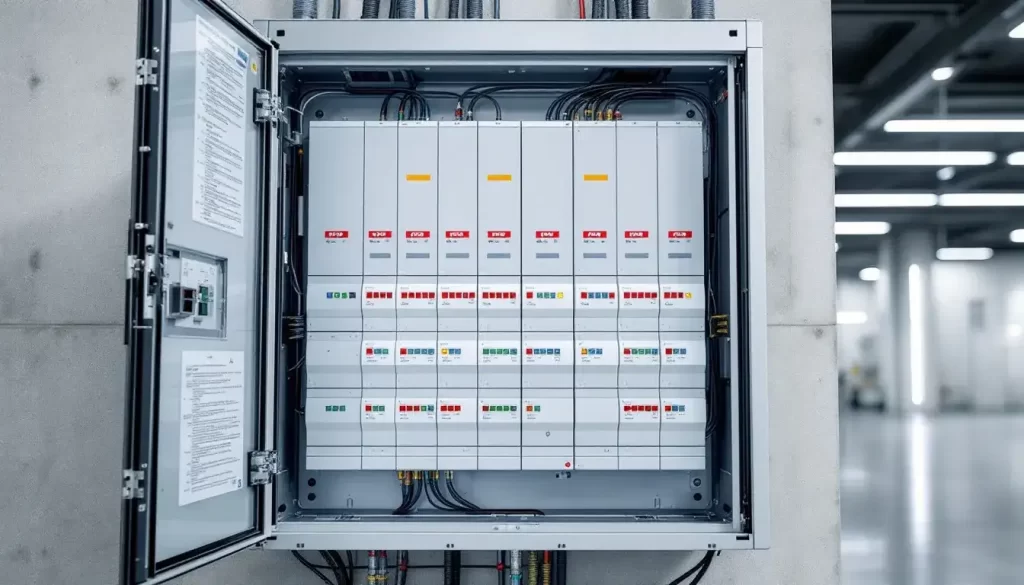
- Προηγμένες λειτουργίες: Πολλά μοντέλα περιλαμβάνουν ηλεκτρονικές μονάδες προστασίας, δυνατότητες επικοινωνίας και παρακολούθηση ενέργειας, υποστηρίζοντας την ενσωμάτωση με χειριστές κινητήρα και τηλεχειρισμό.
- Ολοκληρωμένη προστασία: Προστατεύουν από υπερφορτώσεις, βραχυκυκλώματα και προαιρετικά ρήγματα εδάφους, καθιστώντας τα ευέλικτα για ποικίλες εφαρμογές.
- Βοηθητικά χαρακτηριστικά: Οι βοηθητικές επαφές και η συμβατότητα με άλλες συσκευές προστασίας ενισχύουν τη λειτουργικότητά τους σε πολύπλοκα συστήματα.
Εφαρμογές
Τα MCCB είναι απαραίτητα σε βιομηχανικούς τροφοδότες κινητήρων, μεγάλα συστήματα HVAC, προστασία μετασχηματιστών και εμπορικούς πίνακες διανομής, ειδικά όπου απαιτείται υψηλή ισχύς και ρυθμιζόμενη προστασία.
Περίληψη
Τα MCCB διαφέρουν από τα MCB κυρίως στην χωρητικότητα και την προσαρμοστικότητα, καλύπτοντας περιοχές με υψηλές ενεργειακές απαιτήσεις με προσαρμόσιμη προστασία. Ο στιβαρός σχεδιασμός και τα χαρακτηριστικά τους εξασφαλίζουν αξιόπιστη και αποτελεσματική ασφάλεια του ηλεκτρικού συστήματος για βιομηχανική και εμπορική χρήση.
→Εξερευνήστε την πλήρη γκάμα προϊόντων MCCB που παρέχει η TOSUNlux σε περισσότερες από 90 χώρες.
Βασική σύγκριση: ELCB έναντι RCCB
Εισαγωγή
Η κατανόηση της εξέλιξης από τον διακόπτη διαρροής γείωσης (ELCB) στη σύγχρονη τεχνολογία διακόπτη διαρροής ρεύματος (RCCB) είναι απαραίτητη για τους επαγγελματίες ηλεκτρολόγους, ειδικά όταν ασχολούνται με παλαιότερες εγκαταστάσεις ή αναβαθμίσεις σχεδιασμού. Αυτή η σύγκριση υπογραμμίζει τις βασικές διαφορές, τα πλεονεκτήματα και τις επιπτώσεις στην ασφάλεια και των δύο συσκευών.
Τι είναι το ELCB;
- Ορισμός: Το ELCB είναι μια παλαιότερη συσκευή προστασίας από διαρροές γείωσης που λειτουργεί με τάση και χρησιμοποιήθηκε κυρίως μεταξύ της δεκαετίας του 1960 και του 1980.
- Αρχή Λειτουργίας: Ανιχνεύει σφάλματα γείωσης παρακολουθώντας την αύξηση της τάσης στον αγωγό γείωσης.
- Περιορισμοί:
- Εξαρτάται από την ακεραιότητα της σύνδεσης του ηλεκτροδίου γείωσης.
- Ενδέχεται να μην είναι δυνατή η ανίχνευση ορισμένων τύπων ρηγμάτων γείωσης.
- Περιορισμένη ευαισθησία και πιο αργή απόκριση σε σύγκριση με τις σύγχρονες συσκευές.
- Κατάσταση: Θεωρείται ξεπερασμένη τεχνολογία στη σύγχρονη εποχή ηλεκτρική ασφάλεια πρότυπα.
Τι είναι το RCCB;
- Ορισμός: Το RCCB, επίσης γνωστό ως συσκευή υπολειμματικού ρεύματος (RCD), είναι μια συσκευή ηλεκτρικής προστασίας ευαίσθητη στο ρεύμα, σχεδιασμένη να ανιχνεύει ρεύματα διαρροής προς τη γη.
- Αρχή Λειτουργίας: Παρακολουθεί συνεχώς την ισορροπία ρεύματος μεταξύ των αγωγών υπό τάση και των ουδέτερων αγωγών χρησιμοποιώντας έναν μετασχηματιστή ρεύματος.
- Φόντα:
- Δεν βασίζεται στις συνθήκες του ηλεκτροδίου γείωσης, παρέχοντας πιο αξιόπιστη προστασία.
- Υψηλότερη ευαισθησία στα ρεύματα διαρροής, εξασφαλίζοντας ταχύτερη και ακριβέστερη ανίχνευση.
- Συμμορφώνεται με τα διεθνή πρότυπα ασφαλείας όπως το IEC 61008.
- Ενεργοποιείται εντός χιλιοστών του δευτερολέπτου (συνήθως 30 ms) για την αποφυγή ηλεκτροπληξίας και κινδύνων πυρκαγιάς.
- Εφαρμογές: Χρησιμοποιείται ευρέως σε οικιακές, εμπορικές και βιομηχανικές ηλεκτρικές εγκαταστάσεις για βελτιωμένη ανθρώπινη ασφάλεια.
Συγκριτική Σύνοψη
| Χαρακτηριστικό | ΕΛΚΒ | RCCB |
|---|---|---|
| Τύπος τεχνολογίας | Λειτουργεί με τάση | Λειτουργεί με ρεύμα |
| Ευαισθησία | Περιορισμένο, εξαρτάται από τη γείωση | Υψηλή, ανεξάρτητη από τη γείωση |
| Ανίχνευση βλαβών | Αύξηση τάσης στον αγωγό γείωσης | Τρέχουσα ανισορροπία μεταξύ ενεργού και ουδέτερου |
| Χρόνος απόκρισης | Πιο αργά | Γρήγορο (συνήθως εντός 30 χιλιοστών του δευτερολέπτου) |
| Αξιοπιστία | Χαμηλότερο λόγω εξάρτησης από την ακεραιότητα της γης | Υψηλότερο λόγω της τρέχουσας παρακολούθησης |
| Συμμόρφωση | Ξεπερασμένο, δεν συμμορφώνεται με τα σύγχρονα πρότυπα | Συμμορφώνεται με το πρότυπο IEC 61008 και άλλα πρότυπα |
| Κατάσταση αίτησης | Ως επί το πλείστον σταδιακά καταργημένο | Πρότυπο στη σύγχρονη ηλεκτρική ασφάλεια |
Συστάσεις για ηλεκτρολόγους επαγγελματίες
- Αντικατάσταση: Οι ηλεκτρολόγοι μηχανικοί και τεχνικοί θα πρέπει να συστήνουν την αντικατάσταση των υφιστάμενων εγκαταστάσεων ELCB με σύγχρονα RCCB κατά τη διάρκεια έργων συντήρησης ή αναβάθμισης.
- Συμμόρφωση με τους κανονισμούς ασφαλείας: Η αναβάθμιση σε RCCB διασφαλίζει τη συμμόρφωση με τους ισχύοντες κανονισμούς ασφαλείας και βελτιώνει σημαντικά την προστασία από ηλεκτροπληξία και κινδύνους πυρκαγιάς.
- Ζητήματα Συντήρησης: Τα RCCB απαιτούν τακτικές δοκιμές χρησιμοποιώντας το κουμπί δοκιμής για την επαλήθευση της σωστής λειτουργίας, ενισχύοντας τη μακροπρόθεσμη διασφάλιση της ασφάλειας.
Σύναψη
Η μετάβαση από την τεχνολογία ELCB στην τεχνολογία RCCB αντιπροσωπεύει μια θεμελιώδη πρόοδο στην ηλεκτρική ασφάλεια.
Τα RCCB παρέχουν ανώτερη προστασία μέσω λειτουργίας ευαίσθητης στο ρεύμα, υψηλότερης αξιοπιστίας και ταχύτερων χρόνων απόκρισης. Οι ηλεκτρολόγοι πρέπει να δώσουν προτεραιότητα στην αναβάθμιση των παρωχημένων συστημάτων ELCB σε RCCB για να διασφαλίσουν βέλτιστη απόδοση ασφαλείας και συμμόρφωση με τα σύγχρονα πρότυπα.
MCB έναντι MCCB: Λεπτομερής Σύγκριση
Η διαφορά μεταξύ MCB και MCCB εκτείνεται πέρα από την απλή χωρητικότητα ρεύματος, καλύπτοντας εφαρμογές, χαρακτηριστικά και απαιτήσεις εγκατάστασης που επηρεάζουν τον σχεδιασμό του ηλεκτρικού συστήματος.
| Προσδιορισμός | MCB | MCCB |
|---|---|---|
| Τρέχουσα βαθμολογία | 0,5A – 125A | 100A – 2500A |
| Σπαστή ικανότητα | 6kA – 25kA | 16kA – 200kA |
| Προσαρμογή ταξιδιού | Σταθερά Χαρακτηριστικά | Ρυθμιζόμενες παράμετροι |
| Φυσικό μέγεθος | Συμπαγές (πλάτος 18 χιλιοστών) | Μεγάλο (Πολλές ενότητες) |
| Εφαρμογές | Κατοικίες/Ελαφριές Επαγγελματικές | Βιομηχανική/Βαριά Εμπορική |
| Κόστος | Χαμηλότερος | Υψηλότερο |
| Εγκατάσταση | Απλό πρόσθετο | Βιδωτές συνδέσεις |
Τα MCB υπερέχουν σε οικιακές και ελαφριές εμπορικές εφαρμογές όπου η τυποποιημένη προστασία είναι επαρκής. Τα χαρακτηριστικά σταθερής ενεργοποίησης τους είναι προ-σχεδιασμένα για κοινούς τύπους φορτίου, απλοποιώντας την επιλογή και την εγκατάσταση. Ο συμπαγής σχεδιασμός επιτρέπει υψηλή πυκνότητα κυκλωμάτων σε μονάδες καταναλωτών και πίνακες διανομής.
Τα MCCB εξυπηρετούν βιομηχανικές και βαριές εμπορικές εφαρμογές όπου οι ρυθμιζόμενες ρυθμίσεις διακοπής είναι απαραίτητες για τον συντονισμό του φορτίου και την επιλεκτική λειτουργία.
Η δυνατότητα βελτιστοποίησης των θερμικών και μαγνητικών σημείων ενεργοποίησης επιτρέπει τη βελτιστοποίηση για συγκεκριμένες εφαρμογές, αποτρέποντας την όχληση από την ενεργοποίηση διατηρώντας παράλληλα την προστασία.
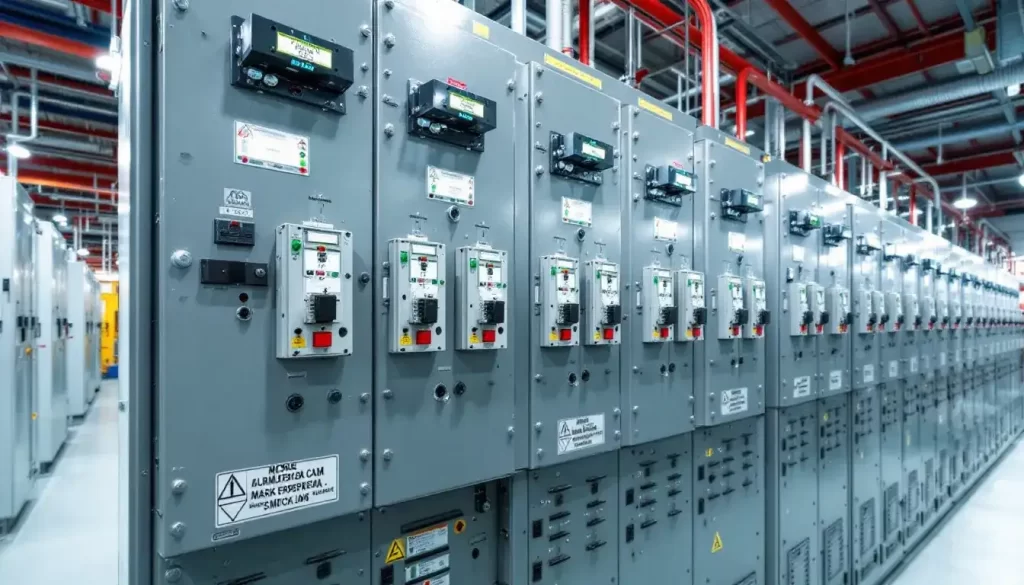
MCB vs RCCB: Επεξήγηση βασικών διαφορών
Η κατανόηση των βασικών διαφορών μεταξύ των μικροαυτόματων διακοπτών (MCB) και των διακοπτών υπολειπόμενου ρεύματος (RCCB) είναι απαραίτητη για τη διασφάλιση της ηλεκτρικής ασφάλειας και της αξιοπιστίας του συστήματος. Αυτές οι συσκευές εξυπηρετούν ξεχωριστούς αλλά συμπληρωματικούς ρόλους στην ηλεκτρική προστασία.
Πεδίο εφαρμογής και σκοπός προστασίας
- MCB (Μικροαυτόματος Διακόπτης):
Σχεδιασμένα για την προστασία των ηλεκτρικών κυκλωμάτων και του εξοπλισμού από συνθήκες υπερέντασης, συμπεριλαμβανομένων των παρατεταμένων υπερφορτώσεων και των αιφνίδιων βραχυκυκλωμάτων. Τα MCB ανιχνεύουν πότε το ρεύμα υπερβαίνει τα προκαθορισμένα όρια και αποσυνδέουν αυτόματα το κύκλωμα για να αποτρέψουν ζημιές στην καλωδίωση και τις συσκευές. - RCCB (Διακόπτης κυκλώματος υπολειπόμενου ρεύματος):
Εστιάζει στην ανθρώπινη ασφάλεια ανιχνεύοντας ρεύματα διαρροής που προκαλούνται από ανισορροπία μεταξύ των αγωγών υπό τάση και των ουδέτερων. Αυτό το ρεύμα διαρροής συχνά υποδεικνύει ρεύμα που ρέει προς τη γη, πιθανώς μέσω ανθρώπινου σώματος ή βλαβών στη μόνωση. Τα RCCB ενεργοποιούνται γρήγορα (εντός 30 χιλιοστών του δευτερολέπτου) για την πρόληψη ηλεκτροπληξίας και κινδύνων πυρκαγιάς.
Μηχανισμοί ανίχνευσης και αντίδρασης
- Λειτουργία MCB:
Χρησιμοποιεί θερμικά και μαγνητικά στοιχεία ενεργοποίησης. Το θερμικό στοιχείο αντιδρά σε παρατεταμένες υπερφορτώσεις μέσω μιας διμεταλλικής ταινίας, ενώ το μαγνητικό στοιχείο αντιδρά άμεσα σε βραχυκυκλώματα μέσω ενός ηλεκτρομαγνήτη. Αυτός ο διπλός μηχανισμός εξασφαλίζει αξιόπιστη αποσύνδεση υπό μη φυσιολογικές συνθήκες ρεύματος. - Λειτουργία RCCB:
Χρησιμοποιεί έναν μετασχηματιστή ρεύματος για τη συνεχή παρακολούθηση της ισορροπίας ρεύματος μεταξύ των αγωγών υπό τάση και των ουδέτερων. Υπό κανονικές συνθήκες, τα ρεύματα είναι ίσα και εξισορροπημένα. Οποιαδήποτε ανισορροπία πέρα από μια προκαθορισμένη ευαισθησία προκαλεί άμεση αποσύνδεση του κυκλώματος.
Εγκατάσταση και Λειτουργική Συμπληρωματικότητα
- Συνδυασμένη χρήση:
Για ολοκληρωμένη ηλεκτρική προστασία, τόσο το MCB όσο και το RCCB εγκαθίστανται συνήθως μαζί. Τα MCB παρέχουν πρωτογενή προστασία από ηλεκτρικά σφάλματα όπως υπερφορτώσεις και βραχυκυκλώματα, ενώ τα RCCB προσθέτουν ένα κρίσιμο επίπεδο προστασίας από ρεύματα διαρροής γείωσης για την προστασία της ανθρώπινης ζωής. - Μη εναλλαξιμότητα:
Καμία από τις δύο συσκευές δεν μπορεί να αντικαταστήσει την άλλη, καθώς αντιμετωπίζουν θεμελιωδώς διαφορετικούς κινδύνους. Ο σωστός σχεδιασμός του ηλεκτρικού συστήματος επιβάλλει την συμπληρωματική τους ενσωμάτωση.
Χαρακτηριστικά απόκρισης και πρακτικές σκέψεις
- Απόκριση MCB:
Επιτρέπει σύντομες συνθήκες υπερέντασης κατά τη διάρκεια μεταβατικών συμβάντων (π.χ. ρεύματα εκκίνησης κινητήρα) χωρίς άσκοπη διακοπή, προστασία εξισορρόπησης και λειτουργική συνέχεια. - Απάντηση RCCB:
Αντιδρά ακαριαία σε οποιοδήποτε ρεύμα διαρροής που υπερβαίνει το όριο ευαισθησίας του, δίνοντας προτεραιότητα στην ταχεία αποσύνδεση για τον μετριασμό των κινδύνων ηλεκτροπληξίας.
Διακρίνοντας με σαφήνεια τους ρόλους, τους μηχανισμούς και τις εφαρμογές των MCB και των RCCB, οι ηλεκτρολόγοι μπορούν να σχεδιάσουν ασφαλέστερα και πιο αξιόπιστα συστήματα που πληρούν τα κανονιστικά πρότυπα και προστατεύουν αποτελεσματικά τόσο τον εξοπλισμό όσο και το προσωπικό.
RCCB εναντίον RCBO: Επιλογή της σωστής λύσης
Η επιλογή μεταξύ ενός RCCB και ενός RCBO είναι ζωτικής σημασίας για τη βελτιστοποίηση της ηλεκτρικής προστασίας, της αποδοτικότητας της εγκατάστασης και της οικονομικής αποδοτικότητας.
RCCB (Διακόπτης κυκλώματος υπολειπόμενου ρεύματος) παρέχει ειδική προστασία από διαρροές γείωσης, αλλά απαιτεί ξεχωριστά MCB για προστασία από υπερένταση.
Αυτή η παραδοσιακή διάταξη επιτρέπει την ανεξάρτητη διαστασιολόγηση των προστατευτικών συσκευών, αλλά απαιτεί περισσότερο χώρο στον πίνακα και πολύπλοκη καλωδίωση, συμπεριλαμβανομένων των κοινόχρηστων ουδέτερων συνδέσεων. Ο σωστός συντονισμός μεταξύ των συσκευών είναι απαραίτητος για την αποφυγή παρεμβολών και τη διασφάλιση αξιόπιστης λειτουργίας.
RCBO (Διακόπτης Υπολειπόμενου Ρεύματος με Προστασία Υπερέντασης) Συνδυάζει την προστασία από διαρροές γείωσης και υπερένταση σε μία μόνο συσκευή. Αυτή η ολοκληρωμένη λύση απλοποιεί την εγκατάσταση εξαλείφοντας την ανάγκη για ξεχωριστά MCB και κοινόχρηστους ουδέτερους, μειώνοντας την πολυπλοκότητα της καλωδίωσης και ελαχιστοποιώντας τα σφάλματα εγκατάστασης.
Παρόλο που τα RCBO έχουν γενικά υψηλότερο αρχικό κόστος από τους συνδυασμούς RCCB συν MCB, εξοικονομούν πολύτιμο χώρο στα πάνελ και μειώνουν το κόστος εργασίας, καθιστώντας τα συνολικά οικονομικά αποδοτικά.
Βασικές σκέψεις:
- Πολυπλοκότητα εγκατάστασης: Τα RCBO βελτιστοποιούν την καλωδίωση και μειώνουν πιθανά σφάλματα. Τα RCCB απαιτούν πιο προσεκτικό συντονισμό.
- Χώρος Πάνελ: Τα RCBO εξοικονομούν πολύτιμο χώρο, ιδανικά για ανακαίνιση ή για πάνελ περιορισμένου χώρου.
- Κόστος: Ενώ οι μονάδες RCBO κοστίζουν περισσότερο μεμονωμένα, το συνολικό κόστος μπορεί να είναι χαμηλότερο όταν λαμβάνεται υπόψη η αποδοτικότητα της εγκατάστασης.
Οι ηλεκτρολόγοι πρέπει να σταθμίζουν αυτούς τους παράγοντες με βάση τις ανάγκες της εφαρμογής, τους περιορισμούς του πίνακα και τον προϋπολογισμό, για να επιλέξουν την καταλληλότερη στρατηγική προστασίας.
Ειδική Σύγκριση: MPCB έναντι MCB / MCCB για Προστασία Κινητήρα
Τι είναι ένα MPCB;
ΕΝΑ Διακόπτης προστασίας κινητήρα (MPCB) είναι μια εξειδικευμένη συσκευή ηλεκτρικής προστασίας προσαρμοσμένη ειδικά για τις μοναδικές απαιτήσεις των ηλεκτροκινητήρων. Παρέχει ολοκληρωμένη προστασία αντιμετωπίζοντας ειδικές για τον κινητήρα συνθήκες όπως:
- Υψηλά ρεύματα εισροήςΔιαχειρίζεται τα μεγάλα ρεύματα εκκίνησης που είναι τυπικά για τους κινητήρες χωρίς ενοχλητική διακοπή.
- Προστασία θερμικής υπερφόρτωσηςΡυθμιζόμενες ρυθμίσεις θερμικής υπερφόρτωσης με χαρακτηριστικά Trip Class 10 ή 20 προστατεύουν τους κινητήρες από υπερθέρμανση κατά τη διάρκεια παρατεταμένης λειτουργίας.
- Ανίχνευση βλάβης φάσηςΠροστατεύει τους τριφασικούς κινητήρες από μονοφασική συνθήκες που μπορούν να προκαλέσουν ταχεία βλάβη στον κινητήρα.
Βασικά χαρακτηριστικά των MPCBs
- Ρυθμιζόμενες ρυθμίσεις θερμικής υπερφόρτωσηςΕπιτρέπει τη λεπτή ρύθμιση των χαρακτηριστικών του κινητήρα, αποτρέποντας περιττές διακοπές κατά τη διάρκεια των κανονικών ρευμάτων εκκίνησης του κινητήρα.
- Ανίχνευση απώλειας φάσηςΑπαραίτητο για την προστασία τριφασικών κινητήρων από καταστροφικές ανισορροπίες φάσης ή απώλειες.
- Λειτουργίες χειροκίνητου ελέγχου κινητήραΣυχνά περιλαμβάνει κουμπιά START/STOP, επιτρέποντας τον άμεσο έλεγχο της λειτουργίας του κινητήρα εκτός από την προστασία.
MPCB έναντι MCB
- Εξειδίκευση έναντι Γενικής ΠροστασίαςΤα MPCB έχουν σχεδιαστεί ειδικά για την προστασία του κινητήρα, ενώ τα MCB παρέχουν γενική προστασία κυκλώματος με σταθερές ρυθμίσεις διακοπής.
- Ρυθμίσεις ταξιδιούΤα MPCB προσφέρουν ρυθμιζόμενες ρυθμίσεις θερμικής διακοπής βελτιστοποιημένες για τη λειτουργία του κινητήρα. Τα MCB έχουν σταθερά χαρακτηριστικά διακοπής που ενδέχεται να προκαλέσουν αδικαιολόγητες διακοπές κατά την εκκίνηση του κινητήρα.
- ΛειτουργικότηταΤα MPCB συχνά περιλαμβάνουν δυνατότητες χειροκίνητου ελέγχου κινητήρα. Τα MCB χρησιμεύουν αποκλειστικά ως συσκευές προστασίας χωρίς λειτουργίες ελέγχου.
MPCB έναντι MCCB
- Πεδίο εφαρμογήςΤα MPCB είναι συμπαγείς και οικονομικά αποδοτικές λύσεις για μεμονωμένους ή μικρότερους κινητήρες, ενσωματώνοντας όλες τις απαραίτητες λειτουργίες προστασίας κινητήρα.
- MCCB: Συνήθως χρησιμοποιούνται ως διακόπτες τροφοδοσίας για μεγαλύτερους κινητήρες και ενδέχεται να απαιτούν εξωτερική θερμικά ρελέ υπερφόρτωσης για πλήρη προστασία του κινητήρα.
- ΟλοκλήρωσηΤα MPCB συνδυάζουν την προστασία και τον έλεγχο του κινητήρα σε μία συσκευή, ενώ τα MCCB ενδέχεται να χρειάζονται πρόσθετα εξαρτήματα για να επιτύχουν το ίδιο επίπεδο προστασίας του κινητήρα.
Τυπικές Εφαρμογές
Τα MPCB διαπρέπουν σε βιομηχανικά περιβάλλοντα που περιλαμβάνουν κινητήρες, αντλίες, συμπιεστές, συστήματα μεταφορικών ταινιών και εξοπλισμό HVAC, όπου τα χαρακτηριστικά προστασίας ειδικά για τον κινητήρα και οι λειτουργίες χειροκίνητου ελέγχου είναι κρίσιμα. Τα κριτήρια επιλογής περιλαμβάνουν την ένταση πλήρους φορτίου (FLA) του κινητήρα, τα χαρακτηριστικά εκκίνησης, τον κύκλο λειτουργίας και τις περιβαλλοντικές συνθήκες.
→Εξερευνήστε την πλήρη γκάμα προϊόντων MPCB που παρέχει η TOSUNlux σε περισσότερες από 90 χώρες.
Πώς να επιλέξετε τον σωστό διακόπτη κυκλώματος: Ένας οδηγός B2B για την εφαρμογή σας
Η επιλογή κατάλληλων συσκευών ηλεκτρικής προστασίας απαιτεί την κατανόηση των απαιτήσεων εφαρμογής, των χαρακτηριστικών φορτίου και των κανονισμών ασφαλείας που επηρεάζουν τις ηλεκτρικές εγκαταστάσεις σε διαφορετικούς τομείς.
Οικιακές Εφαρμογές
Τα MCB συνήθως χειρίζονται γενικό φωτισμό και κυκλώματα πριζών με τυπικά χαρακτηριστικά προστασίας. Τα RCCB ή RCBO είναι απαραίτητα για υγρούς χώρους, όπως μπάνια, κουζίνες και εξωτερικά κυκλώματα, όπου ο κίνδυνος ηλεκτροπληξίας είναι αυξημένος. Οι σύγχρονες εγκαταστάσεις καθορίζουν όλο και περισσότερο RCBO για όλα τα τελικά κυκλώματα, παρέχοντας ολοκληρωμένη προστασία, απλοποιώντας παράλληλα την εγκατάσταση και τη συντήρηση.
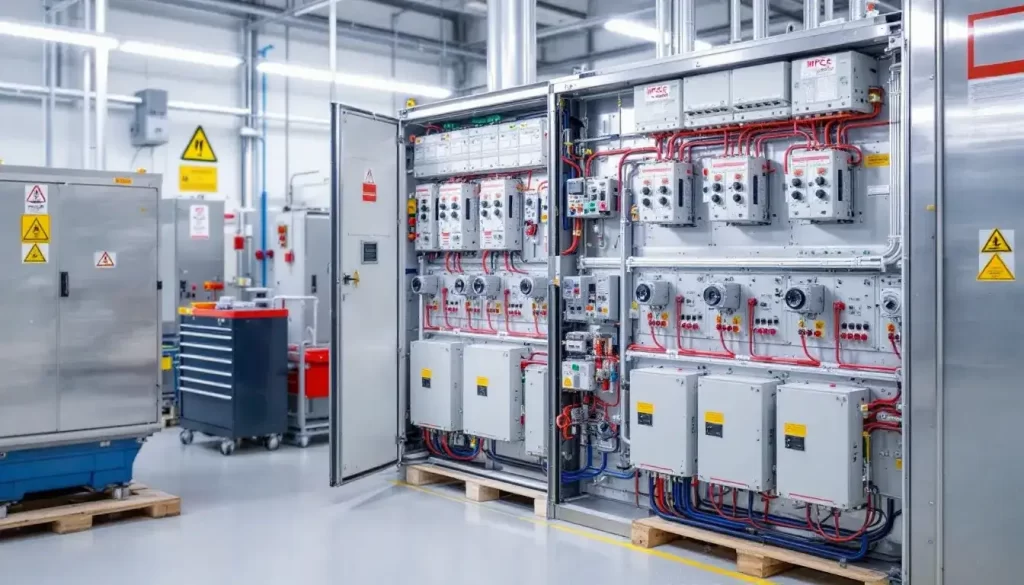
Εμπορικές Εφαρμογές
Τα μεγαλύτερα εμπορικά κτίρια απαιτούν συνδυασμούς MCB για μικρότερα φορτία, RCCB για περιοχές υψηλού κινδύνου και MCCB για κύριους πίνακες διανομής. Τα RCBO προτιμώνται για κρίσιμους ή κοινόχρηστους χώρους όπου είναι απαραίτητη τόσο η προστασία από υπερένταση όσο και η προστασία από διαρροές γείωσης. Οι μελέτες διαφοροποίησης φορτίου και συντονισμού βοηθούν στον προσδιορισμό των βέλτιστων συστημάτων προστασίας.
Βιομηχανικές Εφαρμογές
Τα MCCB συνήθως εξυπηρετούν τα κύρια σημεία διανομής με ρυθμιζόμενες ρυθμίσεις διακοπής για συντονισμό με τις συσκευές κατάντη. Τα MPCB παρέχουν εξειδικευμένη προστασία για μεμονωμένους κινητήρες, αντλίες και βιομηχανικό εξοπλισμό. Τα RCCB διασφαλίζουν την ασφάλεια του προσωπικού σε περιοχές όπου οι εργαζόμενοι ενδέχεται να έρθουν σε επαφή με ενεργοποιημένο εξοπλισμό.
Ηλιακά Φ/Β συστήματα
Οι φωτοβολταϊκές εγκαταστάσεις απαιτούν MCB με ονομαστική ισχύ DC για την προστασία των στοιχειοσειρών και AC RCBO για την προστασία της εξόδου του μετατροπέα. Τα μοναδικά χαρακτηριστικά του ηλεκτρικού τόξου DC και των κινδύνων πυρκαγιάς στα φωτοβολταϊκά συστήματα απαιτούν εξειδικευμένους διακόπτες κυκλώματος σχεδιασμένους για ηλιακές εφαρμογές.
Η επαγγελματική συμβουλευτική καθίσταται απαραίτητη για σύνθετες εγκαταστάσεις που περιλαμβάνουν μελέτες συντονισμού, επιλεκτικές απαιτήσεις λειτουργίας ή εξειδικευμένες εφαρμογές. Οι ηλεκτρολόγοι μηχανικοί μπορούν να παρέχουν ανάλυση φορτίου, υπολογισμούς επιπέδου σφαλμάτων και συντονισμό προστασίας για να διασφαλίσουν τη βέλτιστη απόδοση του συστήματος και τη συμμόρφωση με την ασφάλεια.
Προσφορές της TOSUNlux ολοκληρωμένη τεχνική υποστήριξη και καθοδήγηση επιλογής προϊόντων για να βοηθήσει τους ηλεκτρολόγους επαγγελματίες να επιλέξουν τις βέλτιστες λύσεις διακοπτών κυκλώματος για τις συγκεκριμένες εφαρμογές τους. Η εκτεταμένη γκάμα προϊόντων μας καλύπτει οικιακούς διακόπτες κυκλώματος έως βιομηχανικούς διακόπτες κυκλώματος, εξασφαλίζοντας αξιόπιστη προστασία, ενώ παράλληλα πληροί τα διεθνή πρότυπα και τις κανονιστικές απαιτήσεις.
Συμπέρασμα: Ο μοναδικός σας προμηθευτής για διακόπτες κυκλώματος – TOSUNlux
Εξειδίκευση σε συσκευές ηλεκτρικής προστασίας
Κατανοώντας το σημαντικές διαφορές μεταξύ MCB, RCCB, RCBO, MCCB και MPCB είναι απαραίτητη για τους χονδρεμπόρους ηλεκτρικών ειδών, τους κατασκευαστές πινάκων και τους εργολάβους. Κάθε συσκευή έχει σχεδιαστεί με συγκεκριμένη λειτουργία για να διασφαλιστεί η ασφάλεια και η βέλτιστη απόδοση σε ποικίλα ηλεκτρικά συστήματα. Η εσφαλμένη εφαρμογή ή η αντικατάσταση αυτών των συσκευών μπορεί να θέσει σε κίνδυνο τόσο την ασφάλεια όσο και την αξιοπιστία του συστήματος.
- MCB (Μικροαυτόματοι Διακόπτες) παρέχουν αξιόπιστη προστασία από υπερένταση για χαμηλές ενεργειακές απαιτήσεις και διαφορετικά κυκλώματα σε οικιστικά και ελαφρά επαγγελματικά περιβάλλοντα.
- RCCB (Διακόπτες Υπολειμματικού Ρεύματος) επικεντρωθείτε σε προστασία από διαρροές γείωσης, κρίσιμο για την πρόληψη ηλεκτροπληξίας και την ενίσχυση της ασφάλειας του προσωπικού.
- RCBO (Διακόπτες Υπολειμματικού Ρεύματος με Προστασία Υπερέντασης) συνδυάστε το ίδια λειτουργία ως MCB και RCCB, προσφέροντας ολοκληρωμένη προστασία σε συμπαγή μορφή—ιδανική για εγκαταστάσεις με περιορισμένο χώρο πάνελ.
- MCCB (Διακόπτες Κυκλώματος με Χυτό Περίβλημα) εξυπηρετώ υψηλές δυνατότητες ισχύος σε βιομηχανικές και εμπορικές εφαρμογές, με χαρακτηριστικά ρυθμιζόμενη υπερφόρτωση και ρυθμίσεις ενεργοποίησης για εξατομικευμένη προστασία.
- MPCB (Διακόπτες Προστασίας Κινητήρα) ειδικεύονται στην προστασία ηλεκτρικοί κινητήρες με μοναδικό χαρακτηριστικά ταξιδιού αντιμετώπιση ηλεκτρικών βλαβών που αφορούν ειδικά τον κινητήρα.
Εξουσία και Εμπιστοσύνη: Γιατί να επιλέξετε την TOSUNlux;
Η TOSUNlux αποτελεί έμπιστος ηγέτης στην παροχή υψηλής ποιότητας συσκευών ηλεκτρικής προστασίας που τηρούν αυστηρός διεθνή πρότυπα, συμπεριλαμβανομένων των προδιαγραφών IEC και EN. Τα προϊόντα μας υποβάλλονται σε ολοκληρωμένες δοκιμές για να διασφαλιστεί η ανθεκτικότητα, η αξιοπιστία και η συμμόρφωση σε απαιτητικά περιβάλλοντα.
- Εκτεταμένη γκάμα προϊόντων, από οικιακούς MCB έως βιομηχανικούς MCCB.
- Εξειδίκευση στην ενσωμάτωση συσκευών με χειριστές ηλεκτρικών κινητήρων και υποστηρίζοντας ισχύς αναμονής εφαρμογές.
- Αφοσιωμένη ομάδα τεχνικής υποστήριξης που παρέχει εξατομικευμένη καθοδήγηση για να διασφαλίσει βέλτιστος σχεδιασμός προστασίας κυκλώματος.
- Η δέσμευση στην καινοτομία και την ποιότητα καθιστά την TOSUNlux τον προτιμώμενο συνεργάτη για τους επαγγελματίες ηλεκτρολόγους παγκοσμίως.
Επόμενα βήματα με δυνατότητα εφαρμογής
Για ηλεκτρολόγους μηχανικούς και εργολάβους που αναζητούν αξιόπιστη, συμβατή και αποτελεσματική προστασία κυκλωμάτων:
- Συμβουλευτείτε τους τεχνικούς εμπειρογνώμονες της TOSUNlux για να επιλέξετε συσκευές που ταιριάζουν στις απαιτήσεις της εφαρμογής σας.
- Αξιοποιήστε το ολοκληρωμένο χαρτοφυλάκιο προϊόντων μας για να βελτιστοποιήσετε την προμήθεια και να διατηρήσετε τη συνέπεια.
- Διασφαλίστε τη συμμόρφωση με τους κανονισμούς ασφαλείας και μειώστε το μακροπρόθεσμο κόστος συντήρησης μέσω της επιλογής και εγκατάστασης συσκευών από ειδικούς.
Επικοινωνήστε με την TOSUNlux σήμερα για να συζητήσουμε τις συγκεκριμένες ανάγκες σας και να ανακαλύψουμε πώς οι λύσεις μας για τους διακόπτες κυκλώματος μπορούν να βελτιώσουν την ασφάλεια και την αποδοτικότητα των ηλεκτρικών σας εγκαταστάσεων.
Συχνές Ερωτήσεις
Μπορώ να χρησιμοποιήσω RCBO αντί για ξεχωριστό συνδυασμό MCB και RCCB;
Ναι, τα RCBO μπορούν να αντικαταστήσουν πλήρως τους συνδυασμούς MCB και RCCB, παρέχοντας παράλληλα πανομοιότυπα επίπεδα προστασίας. Τα RCBO προσφέρουν πλεονεκτήματα, όπως μειωμένο χώρο στον πίνακα, απλοποιημένη καλωδίωση και εξάλειψη προβλημάτων κοινής χρήσης ουδέτερων. Ωστόσο, λάβετε υπόψη ότι η βλάβη του RCBO επηρεάζει τόσο την προστασία από υπερένταση όσο και τη διαρροή γείωσης, ενώ οι ξεχωριστές συσκευές επιτρέπουν ανεξάρτητη λειτουργία κατά τη συντήρηση.
Τι συμβαίνει εάν εγκαταστήσω μόνο MCB χωρίς RCCB σε ένα κύκλωμα μπάνιου;
Η εγκατάσταση μόνο προστασίας MCB σε κυκλώματα μπάνιου παραβιάζει τους κώδικες ηλεκτρικής ασφάλειας στις περισσότερες δικαιοδοσίες και δημιουργεί σοβαρούς κινδύνους ηλεκτροπληξίας. Τα μπάνια απαιτούν προστασία από διαρροή γείωσης (RCCB ή RCBO) λόγω της παρουσίας νερού και του αυξημένου κινδύνου ηλεκτροπληξίας. Τα MCB δεν μπορούν να ανιχνεύσουν διαρροή ρεύματος μέσω επαφής με το ανθρώπινο σώμα, με αποτέλεσμα να προκληθούν θανατηφόρες ηλεκτροπληξίες.
Πώς μπορώ να προσδιορίσω τη σωστή βαθμολογία ευαισθησίας για το RCCB σε διαφορετικές εφαρμογές;
Η επιλογή ευαισθησίας RCCB εξαρτάται από την εφαρμογή και τους στόχους προστασίας. Χρησιμοποιήστε 30mA για την προστασία προσωπικού σε οικιακές και εμπορικές εφαρμογές. Τα 10mA παρέχουν ενισχυμένη προστασία για ιατρικές τοποθεσίες ή περιοχές με αυξημένο κίνδυνο ηλεκτροπληξίας. Οι ονομαστικές τιμές από 100mA έως 300mA είναι κατάλληλες για εφαρμογές πυροπροστασίας ή περιοχές όπου η όχληση από κανονικά ρεύματα διαρροής θα μπορούσε να δημιουργήσει λειτουργικά προβλήματα.
Γιατί το RCCB μου σβήνει συχνά και πώς μπορώ να αποτρέψω τυχόν ενοχλητικές διακοπές;
Συχνή διακοπή λειτουργίας του RCCB Συνήθως υποδηλώνει υπερβολικό ρεύμα διαρροής γείωσης από συνδεδεμένο εξοπλισμό, εισροή υγρασίας ή προβλήματα εγκατάστασης. Ελέγξτε για κατεστραμμένα καλώδια, υγρές συνδέσεις ή εξοπλισμό με εγγενή ρεύματα διαρροής. Εξετάστε το ενδεχόμενο χρήσης υψηλότερων βαθμολογιών ευαισθησίας (100mA έναντι 30mA) για κυκλώματα με πολλαπλές ηλεκτρονικές συσκευές ή εγκαταστήστε RCBO για να απομονώσετε προβληματικά κυκλώματα διατηρώντας παράλληλα την προστασία.
Ποια είναι τα απαιτήσεις συντήρησης για διαφορετικούς τύπους διακοπτών κυκλώματος;
Τα MCB και τα RCCB απαιτούν μηνιαία λειτουργία του κουμπιού δοκιμής για την επαλήθευση της μηχανικής λειτουργίας, ετήσια οπτική επιθεώρηση για σημάδια ζημιάς ή υπερθέρμανσης και έλεγχο ροπής των συνδέσεων κάθε 2-3 χρόνια. Τα MCCB χρειάζονται πρόσθετο έλεγχο των ρυθμίσεων της μονάδας προστασίας και των βοηθητικών επαφών. Τα MPCB απαιτούν επαλήθευση φορτίου κινητήρα και επιβεβαίωση της ρύθμισης υπερφόρτωσης. Αντικαταστήστε οποιαδήποτε συσκευή εμφανίζει σημάδια ζημιάς, υπερβολικής φθοράς ή αποτυχίας δοκιμής.
Τηλ: +86-577-88671000
E-mail: ceo@tosun.com
Skype: tosnelectric
Wechat: +86-139 6881 9286
WhatsApp: +86-139 0587 7291
Διεύθυνση: Room No. 1001 Wenzhou Fortune Center, Station Road, Wenzhou, Κίνα
ΖΗΤΗΣΤΕ ΠΡΟΣΦΟΡΑ
WhatsApp μας
 : +86-139 0587 7291
: +86-139 0587 7291 αγγλικός
αγγλικός Español
Español Русский
Русский Français
Français العربية
العربية Português do Brasil
Português do Brasil Українська
Українська Türkçe
Türkçe Polski
Polski Ολλανδία
Ολλανδία ιταλικό
ιταλικό Μπαχάσα Ινδονησία
Μπαχάσα Ινδονησία हिन्दी
हिन्दी اردو
اردو አማርኛ
አማርኛ Ελληνικά
Ελληνικά ไทย
ไทย Μογγολικά
Μογγολικά فارسی
فارسی Shqip
Shqip Ελληνικά
Ελληνικά
